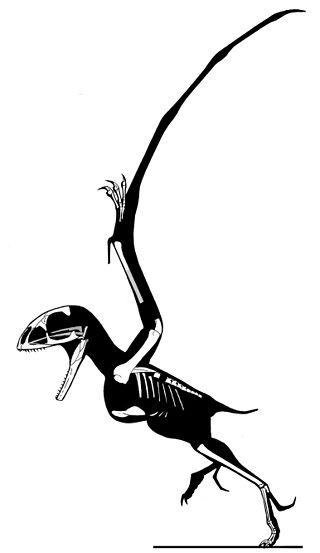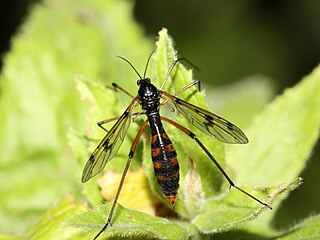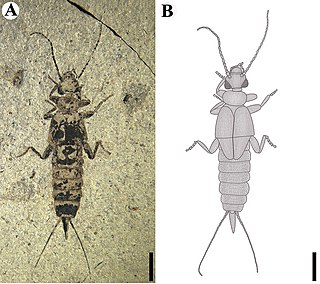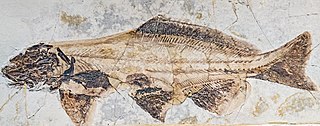
The Trachypachidae are a family of beetles that generally resemble small ground beetles, but that are distinguished by the large coxae of their rearmost legs. There are only six known extant species in the family, with four species of Trachypachus found in northern Eurasia and northern North America, and two species of Systolosoma in Chile and Argentina. They were much more diverse in the past, with dozens of described species from the Mesozoic.

Batrachognathus is an extinct genus of anurognathid pterosaur from the Late Jurassic Karabastau Formation of the central Asian republic of Kazakhstan. The genus was named in 1948 by the Russian paleontologist Anatoly Nicolaevich Ryabinin. The type species is Batrachognathus volans. The genus name is derived from Greek batrakhos, "frog" and gnathos, "jaw", in reference to the short wide head. The specific epithet means "flying" in Latin.

The Cerophytidae are a family of beetles belonging to Elateroidea. Larvae are associated with rotting wood, on which they are presumed to feed. The family contains over 20 species in five genera, primarily distributed in the New World, but also in Eurasia and Africa. 17 fossil species in 7 genera are known extending to the Early Jurassic. Like some other elateroids, the adults are capable of clicking.

Bittacidae is a family of scorpionflies commonly called hangingflies or hanging scorpionflies.

The Ptychopteridae, phantom crane flies, are a small family of nematocerous Diptera. Superficially similar in appearance to other "tipuloid" families, they lack the ocelli of the Trichoceridae, the five-branched radial vein of the Tanyderidae, and the two anal veins that reach the wing margins of the Tipulidae. They are usually allied with the Tanyderidae based on similarities of the mesonotal suture, this group being called the Ptychopteromorpha.

The Tettigarctidae, known as the hairy cicadas, are a small relict family of primitive cicadas. Along with more than 20 extinct genera, Tettigarctidae contains a single extant genus, Tettigarcta, with two extant species, one from southern Australia and one from the island of Tasmania. Numerous fossil species have been described from the Late Triassic onwards. Tettigarcta are the closest living relatives of the true cicadas.

Anaxyelidae is a family of incense cedar wood wasps in the order Hymenoptera. It contains only one living genus, Syntexis, which has only a single species, native to Western North America. Fossils of the family extend back to the Middle Jurassic, belonging to over a dozen extinct genera, with a particularly high diversity during the Early Cretaceous. Syntexis lay eggs in the sapwood of conifers, preferring recently burnt wood.

Osmylidae are a small family of winged insects of the net-winged insect order Neuroptera. The osmylids, also called lance lacewings, stream lacewings or giant lacewings, are found all over the world except North and Central America. There are around 225 extant species.

Psychopsidae is a family of winged insects of the order Neuroptera. They are commonly called silky lacewings.

Protodiplatyidae is an extinct family of earwigs. It is one of three families in the suborder Archidermaptera, alongside Dermapteridae and Turanovia. Species are known from Jurassic and Early Cretaceous fossils and have unsegmented cerci and tarsi with four to five segments.

Coccolepis is an extinct genus of prehistoric marine ray-finned fish in the family Coccolepididae. Originally including most species within the family, it is now restricted to two species from the Late Jurassic Solnhofen Limestone of Germany. The holotype of C. bucklandi, designated and described by Louis Agassiz, was thought to be lost but was later rediscovered in Neuchâtel.

Ithonidae, commonly called moth lacewings and giant lacewings, is a small family of winged insects of the insect order Neuroptera. The family contains a total of ten living genera, and over a dozen extinct genera described from fossils. The modern Ithonids have a notably disjunct distribution, while the extinct genera had a more global range. The family is considered one of the most primitive living neuropteran families. The family has been expanded twice, first to include the genus Rapisma, formerly placed in the monotypic family Rapismatidae, and then in 2010 to include the genera that had been placed into the family Polystoechotidae. Both Rapismatidae and Polystoechotidae have been shown to nest into Ithonidae sensu lato. The larvae of ithonids are grub-like, subterranean and likely phytophagous.
Praeornis is an extinct genus of early avialan, possibly an enantiornithine, from the Late Jurassic Karabastau Formation of Kazakhstan. Only the type species is known, which is P. sharovi.

The Karauridae are a family of stem-group salamanders (Caudata) that are known from the Middle Jurassic to Early Cretaceous in Central Asia, Northern Asia and Western Europe. The family includes four members: Karaurus from the Middle-Late Jurassic Karabastau Formation of Kazakhstan, Kokartus from the Middle Jurassic Balabansai Formation of Kyrgyzstan, Marmorerpeton from the Middle Jurassic Forest Marble Formation of England and Kilmaluag Formation of Scotland, and Kuzbassia from the Early Cretaceous (Aptian) Ilek Formation. The members are some of the oldest known salamanders. The family is united by several morphological characters, including sculptured skull roof bones. Like some modern salamanders, karaurids were neotenic. Members of the family likely fed via suction feeding on small fish and invertebrates. The Early Cretaceous Siberian Kulgeriherpeton has been suggested to be a karaurid by some authors.
Sharovisaurus is an extinct genus of scincomorph lizard from the Late Jurassic of Kazakhstan. It belongs to an extinct family of Mesozoic lizards called Paramacellodidae, which existed across most of Laurasia during the Late Jurassic and Early Cretaceous. The type and only species is Sharovisaurus karatauensis, named in 1984 on the basis of a nearly complete articulated skeleton from the Oxfordian-aged Karabastau Formation.

Archisargidae is an extinct family of brachyceran flies known from the Jurassic and Cretaceous periods. It is part of the extinct superfamily Archisargoidea. Most members of the family are known from the Callovian-Oxfordian Daohugou biota of Inner Mongolia, China, and the equivalently aged Karabastau Formation of Kazakhstan. The family has been found to be paraphyletic with respect to Eremochaetidae in a cladistic analysis.

Coccolepididae is an extinct family of ray-finned fish, known from the Early Jurassic to Early Cretaceous, most of which were originally referred to the type genus Coccolepis. They had a widespread distribution, being found in North and South America, Australia, Asia and Europe. They are mostly known from freshwater environments, though several species have been found in marine environments. They are morphologically conservative, and have poorly ossified endo and exoskeletons, which usually results in poor preservation. This makes it difficult to distinguish species. They are generally small fish, with the largest known specimens reaching a length of 210 mm. Historically, they have been classified as members of “Palaeonisciformes”, a paraphyletic grouping of non-neopterygian fish, due to their plesiomorphic conservative morphology closely resembling those of many other groups of primitive fish. Some recent authors have suggested that they may belong to the order Chondrostei as relatives of the Acipenseriformes.

Peipiaosteidae is an extinct family of fish, known from the Late Jurassic and Early Cretaceous of Asia. They are members of Acipenseriformes, related to sturgeons (Acipenseridae) and paddlefish (Polyodontidae). Fossils have been found in freshwater deposits in China, Russia, Kazakhstan, and Mongolia. They are generally considered either the earliest diverging group of Acipenseriformes, or the sister group to the clade containing Acipenseridae and Polyodontidae. At least Yanosteus was likely to have been piscivorous, based on a specimen of Lycoptera found in the mouth of one specimen.
Turseodus is an extinct genus of ray-finned fish found in Late Triassic freshwater sediments of the United States. Two species have been described, T. acutus from the Lockatong Formation of Pennsylvania, and T. dolorensis from the Chinle Formation of Colorado.
Pteroniscus is an extinct genus of prehistoric "palaeoniscoid" ray-finned fish that lived during the Jurassic period in what is now Kazakhstan, Central Asia. Fossils were recovered from the late Middle Jurassic or early Late Jurassic (Callovian/Oxfordian) Karabastau Formation in the Tian Shan mountains.

















